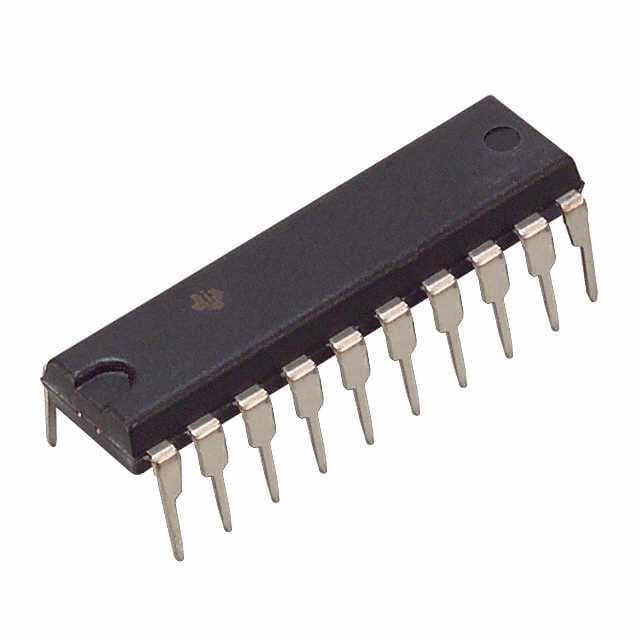SN74ABT640N
Product Overview
- Category: Integrated Circuit
- Use: Bus Transceiver
- Characteristics: High-speed, non-inverting, 3-state transceiver
- Package: PDIP (Plastic Dual-In-Line Package)
- Essence: Converts signals between two bidirectional bus systems
- Packaging/Quantity: Available in tubes of 25 units or reels of 2000 units
Specifications
- Supply Voltage Range: 4.5V to 5.5V
- Input Voltage Range: 0V to VCC
- Output Voltage Range: 0V to VCC
- Operating Temperature Range: -40°C to +85°C
- Maximum Propagation Delay: 6ns
- Maximum Output Current: ±24mA
Detailed Pin Configuration
The SN74ABT640N has a total of 20 pins, which are assigned as follows:
- OE (Output Enable) - Active Low Output Enable
- A1-A8 (Input/Output) - Bidirectional Data Bus
- B1-B8 (Input/Output) - Bidirectional Data Bus
- GND (Ground) - Ground Reference
- BDIR (Bus Direction) - Controls the direction of data flow
- VCC (Supply Voltage) - Positive Power Supply
- B1-B8 (Input/Output) - Bidirectional Data Bus
- A1-A8 (Input/Output) - Bidirectional Data Bus
- OE (Output Enable) - Active Low Output Enable
- GND (Ground) - Ground Reference
Functional Features
- Non-inverting 3-state outputs
- Bidirectional data flow between two bus systems
- Active low output enable for easy control
- High-speed operation for efficient data transfer
- TTL-compatible inputs for easy integration with other devices
Advantages and Disadvantages
Advantages: - High-speed operation allows for quick data transfer - Non-inverting outputs simplify signal processing - 3-state outputs provide flexibility in bus systems - Active low output enable enhances control capabilities
Disadvantages: - Limited supply voltage range (4.5V to 5.5V) - Propagation delay of 6ns may not be suitable for certain applications - Maximum output current of ±24mA may restrict use in high-current scenarios
Working Principles
The SN74ABT640N is a bus transceiver that converts signals between two bidirectional bus systems. It operates by controlling the direction of data flow using the BDIR pin. When BDIR is set to logic low, data flows from the A bus to the B bus. Conversely, when BDIR is set to logic high, data flows from the B bus to the A bus.
The non-inverting 3-state outputs allow the SN74ABT640N to drive the bus lines without altering the signal polarity. The active low output enable (OE) pin enables or disables the outputs, providing control over the data transmission.
Detailed Application Field Plans
The SN74ABT640N is commonly used in various applications, including:
- Data communication systems
- Microprocessor-based systems
- Industrial automation
- Automotive electronics
- Networking equipment
Its ability to convert signals between different bus systems makes it suitable for applications requiring bidirectional data transfer.
Detailed and Complete Alternative Models
- SN74ABT640DW - SOIC (Small Outline Integrated Circuit) package
- SN74ABT640DBR - SSOP (Shrink Small Outline Package) package
- SN74ABT640PWR - TSSOP (Thin Shrink Small Outline Package) package
- SN74ABT640DWR - SOIC package
These alternative models offer different package options to suit specific design requirements while providing similar functionality to the SN74ABT640N.
In conclusion, the SN74ABT640N is a high-speed, non-inverting bus transceiver that allows bidirectional data flow between two bus systems. Its active low output enable and 3-state outputs provide control and flexibility in various applications. While it has certain limitations, such as a limited supply voltage range and propagation delay, there are alternative models available to cater to different packaging needs.
قم بإدراج 10 أسئلة وإجابات شائعة تتعلق بتطبيق SN74ABT640N في الحلول التقنية
Sure! Here are 10 common questions and answers related to the application of SN74ABT640N in technical solutions:
Q: What is SN74ABT640N? A: SN74ABT640N is a type of octal bus transceiver with 3-state outputs, commonly used in digital systems.
Q: What is the purpose of SN74ABT640N? A: SN74ABT640N is used to enable bidirectional transfer of data between two buses with different voltage levels or logic families.
Q: What is the maximum operating voltage for SN74ABT640N? A: The maximum operating voltage for SN74ABT640N is typically 5.5V.
Q: Can SN74ABT640N handle level shifting between different voltage domains? A: Yes, SN74ABT640N can handle level shifting between different voltage domains, making it suitable for interfacing between different logic families.
Q: How many bits can SN74ABT640N handle? A: SN74ABT640N is an octal transceiver, meaning it can handle 8 bits of data.
Q: Does SN74ABT640N support 3-state outputs? A: Yes, SN74ABT640N supports 3-state outputs, allowing multiple devices to share a common bus without interfering with each other.
Q: What is the maximum data transfer rate supported by SN74ABT640N? A: The maximum data transfer rate supported by SN74ABT640N is typically around 200 MHz.
Q: Can SN74ABT640N be used in both synchronous and asynchronous applications? A: Yes, SN74ABT640N can be used in both synchronous and asynchronous applications, depending on the system requirements.
Q: Does SN74ABT640N have built-in protection features? A: Yes, SN74ABT640N has built-in ESD (Electrostatic Discharge) protection to safeguard against static electricity damage.
Q: What are some common applications of SN74ABT640N? A: SN74ABT640N is commonly used in data communication systems, memory interfaces, bus arbitration, and other digital systems requiring bidirectional data transfer.
Please note that the answers provided here are general and may vary based on specific datasheet specifications and application requirements.


